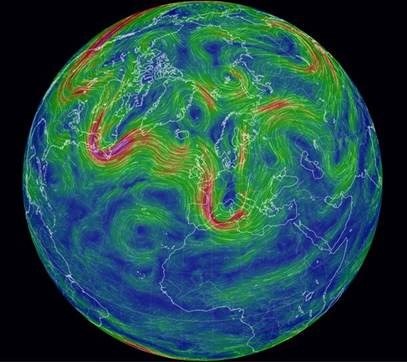WAVE
WAVE – Waves in the Middle Atmosphere as Indicators for the Early Detection of Climate Signals: Development of methodologies to improve forecasts of extreme weather situations in Bavaria and the Alpine region
© nullschool.net
According to the current state of knowledge, climate change leads to spatially distinct temperature changes. At high latitudes a stronger temperature increase can be observed than at lower latitudes. This immediately affects large-scale atmospheric airflow patterns, so-called planetary waves, with corresponding impacts on the general weather situation at our geographic latitudes. The general weather situation, on its part, governs the occurrence and markedness of extreme cold and hot periods as well as droughts and extreme precipitation events. Present knowledge about the actual effects of climate change on the dynamics of the atmosphere is however still deficient, so long-term forecasts are imprecise.
Within the framework of the WAVE project, the extent to which the amplitude and phase of planetary waves have changed in recent years is to be investigated. Distinctions must be made between natural (for example, solar) and anthropogenic effects. One focus is on small-scale planetary waves; since they frequently lead to high or low pressure regions separating off from the background atmospheric airstream if they are highly dynamic. So-called Vb-weather conditions have a particularly high damage potential. They cause very intensive strong rainfall in the Alpine region. An attempt will be made to relate the prevailing planetary wave structure function to the likelihood of an imminent extreme weather situation in Bavaria, the Alpine region, and neighbouring areas.
On this basis, the WAVE project focuses on strong, low pressure areas like Vb-systems. Using measurements from various Alpine VAO stations as well as a station of the newly associated VAO partner Czech Republic, which is frequently affected by Vb-cyclones, an innovative approach will be investigated to detect and record changes in the energy content of such powerful low pressure systems. This parameter is important for improved forecasting of the path and strength of these systems.

